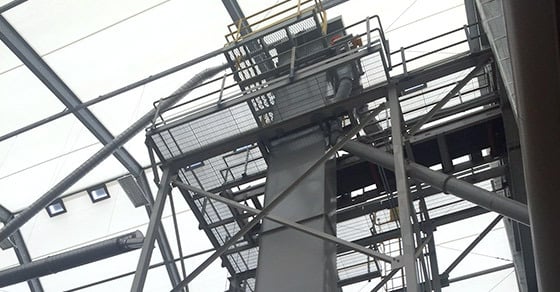Bucket elevators are the standard equipment for vertically conveying bulk solids, applicable to a wide range of materials, and capable of accommodating high-capacity handling.
While bucket elevators consist of fairly standard designs, they still offer plenty of opportunity for customization in order to achieve a vertical handling solution optimized for the job at hand.
Below are the options available to turn a standard bucket elevator into an efficient, tailored bulk handling solution.
Please note that some of the specifications listed here may be specific to FEECO International.
Handling Style
Bucket elevators can be configured in a variety of different ways in order to achieve the precise handling behavior required by the material being conveyed. Customizations include:
Centrifugal or Continuous
Bucket elevators are available in either a centrifugal or continuous discharge design. Each configuration uses a different mode of action to load and discharge the material.
Centrifugal elevators are chosen for high-capacity handling of free-flowing materials, while continuous elevators are preferred when gentle handling is required, or when the material is easily aerated or consists of large lumps.
Centrifugal elevators scoop material up from the boot section and then throw it out via centrifugal force as buckets pass over the head pulley. As such, the action of this style is more suited to materials where degradation is not a concern.
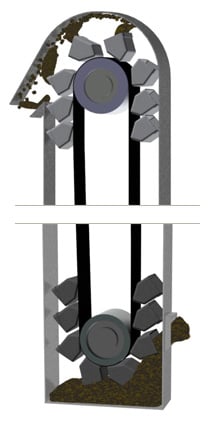
In contrast, continuous elevators are directly loaded from a chute and instead of throwing material, gently cascade it over the back of the preceding bucket into the discharge chute for gentle unloading.
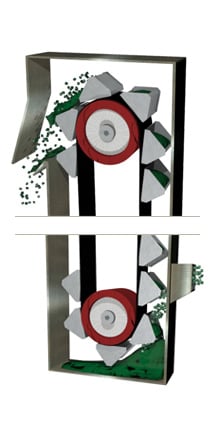
Bucket Style
The bucket style, of which there are many to choose from, also impacts the handling style of the unit. The bucket style should be selected to enhance the action of the continuous or centrifugal elevator. For example, buckets used with a centrifugal elevator should be shaped in a way that maximizes the scooping action of the bucket.
Materials of Construction and Surface Treatment
The diverse range of facilities in which bucket elevators perform requires an equally diverse set of surface treatments. This can be accomplished through the material of construction or by a paint system or other surface treatment.
Material of Construction
Bucket elevators are generally constructed from carbon steel as a standard. When working in a corrosive environment, however, carbon steel is typically not sufficient. For corrosive settings, stainless steel is a more appropriate material of construction, as it will effectively ward off corrosion from the environment or the material being conveyed.
Surface Treatments
Carbon steel bucket elevators can be protected with various paint treatments suited to the application. A standard paint system may consist of a single coat of epoxy, 5-7 mil dry film thickness (DFT), but many different types of paints are available to suit different objectives. For example, a client may require their facility’s equipment to meet certain paint specifications, which FEECO can accommodate.
Stainless steel does not require further protection in the form of a surface treatment, but can benefit from them when aesthetics are a concern. Several options are available to improve the look of stainless steel, including ice blasting, bead blasting, and pickling and passivating.
Improved Operation
Several types of sensors and switches are available for streamlining bucket elevator operation and performance. Often selected to enhance elevator functionality and minimize downtime, this includes:
Zero-speed switches
When using a screw-type take-up, zero-speed switches can be mounted on the boot shaft to alert the operator when either the shaft or buckets have stopped moving. This helps to detect a potential problem before it has a chance to escalate, allowing the operator to adjust accordingly and prevent an upset.
When using an internal gravity-type take-up, a motion sensor is mounted to the casing to sense the buckets passing.
E-stops
E-stops provide an emergency “off” switch in the event that a hazardous condition should arise, serving as an extra layer of safety for operators and personnel in the facility.
Plugged Chute Switch
Similar to the zero-speed switch, a plugged chute switch serves as a buffer in the process, providing the operator the opportunity to rectify a potential issue before it causes a process upset. The plugged chute switch monitors the flow of material through the designated area, alerting the operator when flow becomes obstructed.
Gravity Take-up Over Travel Switch
By utilizing a gravity take-up over travel switch, one can determine if the chain has stretched too far, and should be modified or replaced.
Maintenance & Accessibility
In addition to the handling style, surface treatment, and sensors that can be added to enhance the functionality and efficiency of a bucket elevator, several options are available to improve the maintenance and accessibility of the unit as well. Common customizations in this category include:
Platforms
Platforms around the elevator head section, as well as at intermediate points along the elevator, provide a safe and stable way to access and service the bucket elevator. All FEECO platforms, ladders, and safety cages are designed in compliance with OSHA regulations.
Ladders, Safety Cages, and Stairways
If the elevator is positioned in a way that does not allow accessibility via surrounding infrastructure, ladders with safety cages, or stairways can provide a point of access to the unit.
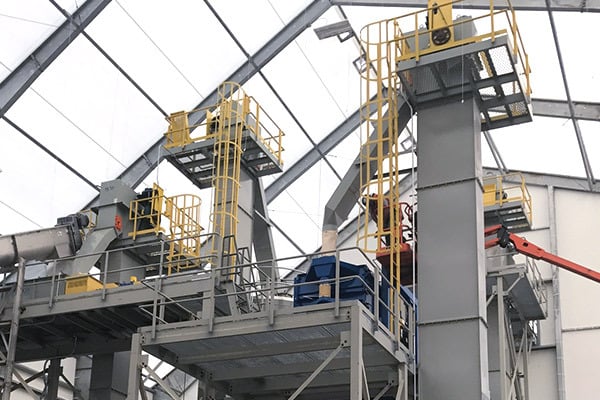
FEECO Bucket Elevators with ladders, safety cages, and head platforms
Segmented Rim Sprockets
Segmented rim sprockets significantly reduce the time and labor required to replace a worn sprocket (when working with a chain-driven elevator). With a traditional one-piece solid construction sprocket, the head shaft, buckets, chain, and other components must be completely removed – a time- and labor-intensive endeavor.
A segmented rim sprocket simplifies this procedure by allowing operators to replace a section of the sprocket, jog the elevator to the next segment and replace that, and jog it a final time to replace the third segment – all without disassembly of the elevator, significantly cutting down on time and labor, as well as the risk associated with disassembly.
Access Doors
Access doors allow entry into the elevator for maintenance and cleanout such as shoveling out the boot section or replacing buckets. While access doors are standard on all bucket elevators, several upgrades are available to improve their functionality:
Size
The size of the standard access door depends on the size of the elevator casing and where on the elevator the door will be placed (boot section doors are typically much larger than doors for the intermediate section).
An average elevator may have a 24” x 36” intermediate section access door opening. These doors can be enlarged to allow easier accessibility to the unit – for example, 3’ x 6’.
Note that access doors are distinctly different from inspection doors, which are smaller and serve only to provide a visual into the elevator’s interior – not actual access.
Door Attachment
Standard access doors are of the bolt-on design. While this provides an adequate door, it may require a few people to lift and remove the door when access is needed. To improve on this, access doors can be hinged on to the elevator casing, or provided as a boom-style attachment that allows the door to swing out of the way.
Gravity Take-up or Screw Take-up
When working with belt elevators, the take-up is adjusted to account for excess slack in the belt produced as a result of stretching over time. The screw-type take-up is standard on FEECO belt elevators and involves manual adjustment of the belt tension.
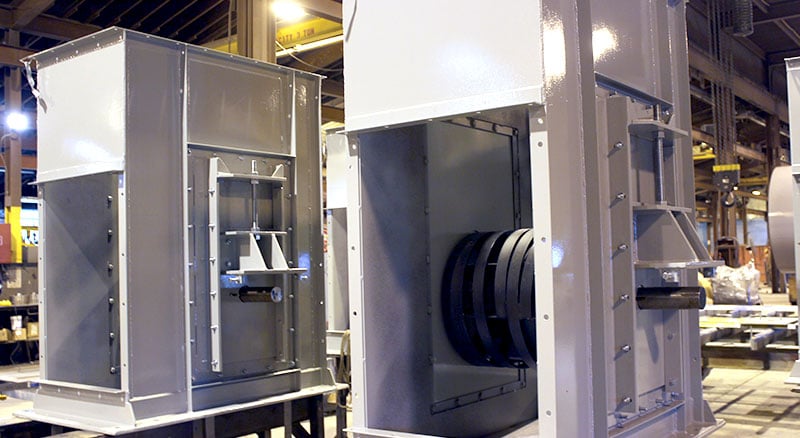
Boot casing of a bucket elevator with a screw-type take-up (screw take-up not yet installed)
Chain elevators, on the other hand, can include either a manual screw-type take-up, or a gravity-type take-up. A gravity-type take-up automatically adjusts the chain tension, reducing the supervision and maintenance required of the system and also preventing the accidental over-tensioning of the belt that can occur with manual adjustment.
Additionally, with the FEECO internal gravity take-up system, the shaft does not protrude through the casing wall, thus eliminating the need for shaft seals and potential material leakage.
Belt or Chain
The choice of a belt or chain elevator is largely dependent on the material characteristics and handling parameters. When the belt elevator is selected, various options are available to improve its resistance to wear, such as when working with hot or corrosive materials. This includes different belt covers, as well as high-temp belts.
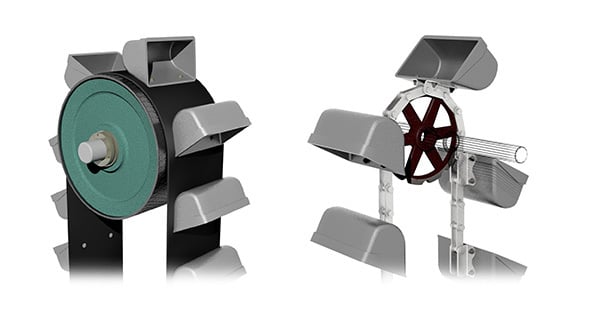
Belt bucket elevator (left) and chain bucket elevator (right)
Wash-out Drain Connections
Wash-out drain connections can also be supplied for improved cleaning of the boot.
Dust Pick-Offs
Dust collection pick-off points can be added to the head or boot for dust removal.
Conclusion
Bucket elevators are a cornerstone of industrial processing and handling facilities, allowing high-capacity vertical handling for many different types of bulk solids. While they are fairly standard in their overall design, bucket elevators can be customized in a number of ways to yield an optimized bulk handling system.
FEECO has been engineering and manufacturing custom bucket elevators and other bulk solids handling equipment since 1951. Our bucket elevators are in operation throughout various industries, from aggregates to chemicals and everything in between. For more information on our bucket elevators, contact us today!

